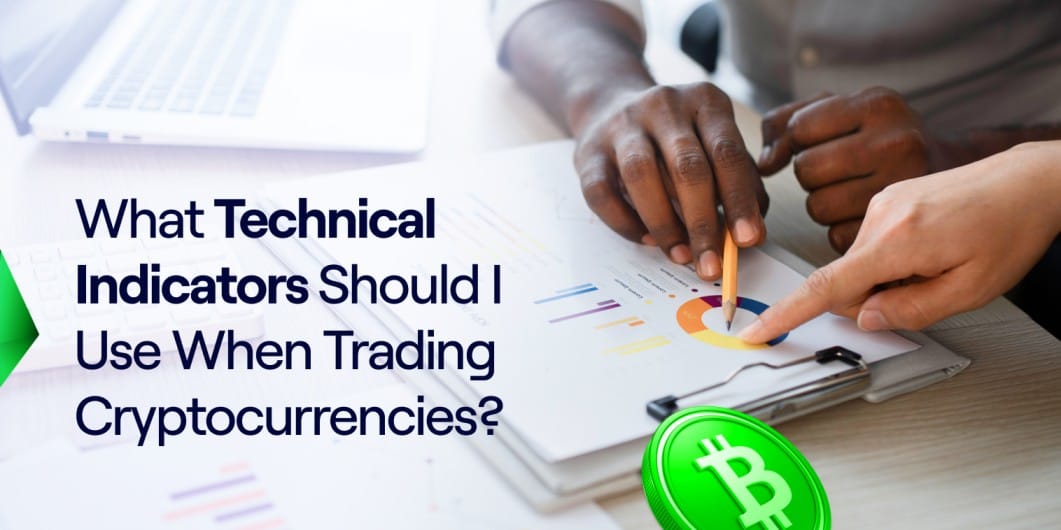
11 Best Indicators for Crypto Trading in 2024: A Beginner-Friendly Guide
In the fast-paced crypto world, using the best indicators for crypto trading can help navigate the big ups, downs, and surprises. In this fast-moving environment, technical indicators are your guide, helping you make better trading decisions.
Think of the best indicators for crypto trading as helpful tools. They look at past price and volume data to show patterns and give clues about when to enter or exit trades. Whether you're new to crypto or have been trading for a while, these tools can help you trade more confidently.
In this easy-to-understand guide, we'll explain 11 key technical indicators so you can use them in your trading. Get ready because we'll help you become a more skilled trader.
Here’s what we’ll cover:
Trend Indicators: Spot The Big Moves Using The Best Indicators for Crypto Trading
- Moving Averages (MA)
- Moving Average Convergence Divergence (MACD)
- Relative Strength Index (RSI)
- Average Directional Index (ADX)
Momentum Indicators: Catch the market's speed
- Stochastic Oscillator
- Williams %R
Volume Indicators: See the market's interest and changes
- On-Balance Volume (OBV)
- Volume-Weighted Average Price (VWAP)
Volatility Indicators: Manage risk in uncertain markets
- Bollinger Bands
- Average True Range (ATR)
Other Useful Indicators:
- Ichimoku Cloud
By the end of this guide, you’ll understand how to use the best indicators for crypto trading to make smart decisions.
Trend Indicators: Spot The Big Moves In The Market
Knowing where the market is going is important in crypto trading. Trend indicators help you see if prices are going up or down, allowing you to make better decisions.
1. Moving Averages (MA) - Making the Trend Clear
Imagine trying to sail through rough seas without a compass. Trading without trend indicators can feel the same way. Moving averages are considered some of the best indicators for crypto trading because they smooth out price fluctuations.
What are they? Moving averages are lines on a chart that show the average price of a cryptocurrency over a set period of time. They help you see the bigger trend by filtering out the daily price changes.
Simple vs. Exponential MA:
- Simple Moving Average (SMA): Calculates the average price over a specific time, with equal weight for all prices.
- Exponential Moving Average (EMA): This index puts more weight on recent prices, allowing it to react faster to new changes.
How to use them:
- Identify trend direction:
- If the price is above the MA, it's likely an uptrend.
- If the price is below the MA, it's likely a downtrend.
- Spot support and resistance levels:
- MAs can act as moving support or resistance points.
- In an uptrend, the price often bounces off the MA when it dips.
- In a downtrend, the price may struggle to move above the MA.
Common MA lengths:
- 50-day MA: Reflects the medium-term trend.
- 200-day MA: Reflects the long-term trend.
Example:
2. Moving Average Convergence Divergence (MACD) - Spotting Trend Changes
While moving averages show you the current trend direction, the MACD helps you spot when that trend might be about to change. Think of it as an early warning signal for market shifts.
What is it? The MACD is a tool that shows the relationship between two moving averages of a cryptocurrency's price. It includes:
- MACD line: The difference between a short-term and long-term moving average (EMA).
- Signal line: A moving average of the MACD line.
- Histogram: Shows the difference between the MACD line and the signal line.
How to use it:
- Spot trend changes:
- When the MACD line crosses above the signal line, it may indicate an upward (bullish) trend.
- When the MACD line crosses below the signal line, it may signal a downward (bearish) trend.
- Identify buy/sell signals:
- Watch for differences between the MACD and the price:
- A bullish divergence happens when the price makes a new low, but the MACD makes a higher low.
- A bearish divergence happens when the price hits a new high, but the MACD makes a lower high.
- Watch for differences between the MACD and the price:
Read More:
- What Are the Best Practices for Managing My Crypto Assets?
3. Relative Strength Index (RSI) - Checking Market Speed
The Relative Strength Index (RSI) helps you understand how strong a price move is and whether it’s likely to continue or slow down.
What is it? RSI is a tool that measures recent price changes to see if an asset, like a stock, is either too expensive (overbought) or too cheap (oversold).
How to use it:
- Spot overbought/oversold conditions:
- If the RSI is above 70, the asset might be overbought and could drop soon.
- If the RSI is below 30, the asset might be oversold and could rise soon.
- Identify trend reversals:
- Watch for differences between the RSI and the price:
- A bullish divergence happens when the price hits a new low, but the RSI shows a higher low.
- A bearish divergence happens when the price reaches a new high, but the RSI shows a lower high.
- Watch for differences between the RSI and the price:
Key levels:
- 30: Oversold
- 70: Overbought
Example:
4. Average Directional Index (ADX) - Measuring Trend Strength
Knowing the direction of the trend is one thing, but knowing its strength is equally important. The Average Directional Index (ADX) helps you determine whether a trend is strong enough to warrant your attention or if it's likely to fizzle out.
What is it? ADX is a trend strength indicator that measures the strength of a trend, regardless of its direction.
How to use it:
- Confirm if a trend is strong enough to trade:
- ADX values above 25 suggest a strong trend.
- ADX values below 25 suggest a weak trend.
- Use in conjunction with other indicators:
- ADX is best used with other indicators to confirm trend direction and potential entry/exit points.
Key levels:
- 25: Threshold for a strong trend.
Example:

Download the Busha App Today and Start Trading Smarter!
Momentum Indicators: Spotting Market Speed
While trend indicators give you the overall market direction, momentum indicators show how strong a price move is. This helps you know when to enter or exit a trade before everyone else. Let’s break down two popular momentum indicators.
5. Stochastic Oscillator - Measuring Price Strength
Think of a surfer riding a wave. They need to know the direction and how strong the wave is. The Stochastic Oscillator helps you see if the price is moving with force or about to slow down.
- What is it? The Stochastic Oscillator compares the closing price of a cryptocurrency to its price range over a specific time (usually 14 days).
- How it works: It uses two lines:
- %K line: Tracks the closing price compared to the high and low prices.
- %D line: A moving average of the %K line, acting as a signal line.
- How to use it:
- If the %K line goes above 80, the asset might be overbought (due to a price drop).
- It might be oversold if it goes below 20 (due to a price bounce).
- Watch for crossovers between the %K and %D lines to spot trend changes. A bullish signal happens when %K crosses above %D, and a bearish signal occurs when %K crosses below %D.
You Might Also Like:
- Top 10 Applications of Blockchain Technology Beyond Finance
6. Williams %R - Spotting Quick Moves
Similar to the Stochastic Oscillator, Williams %R is another tool for identifying overbought or oversold assets. It looks at the latest closing price compared to the recent high and low, making it sensitive to short-term price changes.
What is it? Williams %R is a momentum indicator that compares a cryptocurrency's closing price to its highest and lowest prices over a certain time period (usually 14 days).
How to use it:
- Spot overbought/oversold conditions:
- If the value is above -20, the asset might be overbought.
- If the value is below -80, the asset might be oversold.
- Identify potential trend reversals:
- Watch for differences between Williams %R and the price:
- A bullish divergence happens when the price makes a new low, but Williams %R makes a higher low.
- A bearish divergence happens when the price makes a new high, but Williams %R makes a lower high.
- Watch for differences between Williams %R and the price:
Key levels:
- -20: Overbought level
- -80: Oversold level

Download the Busha App Today and Start Trading Smarter!
Volume Indicators: Watching Market Activity
Volume is the heartbeat of any market. These indicators help you see how much interest and participation there is in a cryptocurrency, indicating the strength of a trend or a possible change in direction.
7. On-Balance-Volume (OBV) - Tracking Buying and Selling
Consider OBV as a way to see the market’s flow, like watching a river's current. It tracks the total buying and selling volume to show if more people are buying or selling.
- What is it? OBV adds or subtracts volume based on whether the closing price is higher or lower than the previous day.
- How to use it:
- A rising OBV suggests buying pressure (an uptrend).
- A falling OBV suggests selling pressure (a downtrend).
- Look for divergences between OBV and the price to spot possible trend reversals.
Related Posts:
- What Are the Latest Cryptocurrency Tax Regulations for 2024? (Nigeria Focus)
- Signs to Look Out for When It's Time to Sell Your Cryptocurrency
8. Volume-Weighted Average Price (VWAP) - Checking Fair Value
VWAP helps you determine if the current price is fair in a busy market by averaging the trading price based on daily volume.
- What is it? VWAP gives you the average price of a cryptocurrency traded during the day based on volume and price.
- How to use it:
- In an uptrend, the price tends to stay above VWAP.
- In a downtrend, the price tends to stay below VWAP.
- If the price is above VWAP, it could be overvalued; if it's below, it could be undervalued.
Understanding these momentum and volume indicators allows you to make smarter trading decisions and spot opportunities before others.
Volatility Indicators: Handling Market Swings with the Best Indicators for Crypto Trading
Cryptocurrency prices can change quickly, offering both opportunities and risks. Volatility indicators help you understand these price swings so that you can trade more confidently.
9. Bollinger Bands - Tracking Market Movements
Think of Bollinger Bands like a heartbeat monitor, showing you the highs and lows of the market's movement. They help you see how much a cryptocurrency’s price is fluctuating.
What are they? Bollinger Bands are made up of three lines:
- Middle Band: A 20-day moving average that shows the average price.
- Upper Band: Two standard deviations above the middle band, showing the high range.
- Lower Band: Two standard deviations below the middle band, showing the low range.
How to use them:
- Spot volatility: Wide bands mean higher volatility; narrow bands mean lower volatility.
- Overbought/oversold conditions: If the price touches the upper band, it may be overbought. If it touches the lower band, it may be oversold.
- Identify trend reversals: A breakout above the upper band may signal an uptrend, while a breakout below the lower band may signal a downtrend.
10. Average True Range (ATR) - Measuring Volatility
If Bollinger Bands are like a heartbeat monitor, ATR is like a scale measuring how intense the market moves. It shows the average price movement over a period (usually 14 days), helping you gauge how volatile a cryptocurrency has been.
What is it? ATR measures how much a cryptocurrency's price moves between its highs and lows over a given period, considering gaps.
How to use it:
- Gauge volatility: A high ATR means high volatility, while a low ATR means low volatility.
- Set stop-loss levels: In a high-volatility market, set wider stop-loss levels to avoid getting stopped out too soon. In low volatility, a narrow stop-loss might be more appropriate.

Other Useful Indicators - The Ichimoku Cloud
The Ichimoku Cloud is like a weather map for crypto trading, showing current trends and potential future movements.
11. Ichimoku Cloud - A Multi-Tool Indicator
The Ichimoku Cloud combines several indicators into one. It provides information about trends, support, resistance, and momentum, helping you decide when to enter or exit a trade.
What is it? The Ichimoku Cloud includes several lines and a "cloud" that help you understand the market's past, present, and future movements:
- Trend direction: The cloud's color and the price's position relative to it show the trend.
- Support and resistance: The cloud's edges and the lines act as support and resistance levels.
- Momentum: The position of the price in relation to the cloud and lines shows momentum.
- Entry/exit points: Crossovers between the lines and price generate signals for trading.
Key components:
- Tenkan-sen (Conversion Line): The highest and lowest prices average over the past 9 periods.
- Kijun-sen (Base Line): The highest and lowest prices average over the past 26 periods.
- Senkou Span A (Leading Span A): The midpoint of Tenkan-sen and Kijun-sen, projected 26 periods into the future.
- Senkou Span B (Leading Span B): The average of the highest and lowest prices over the past 52 periods, projected 26 periods into the future.
- Chikou Span (Lagging Span): The current closing price plotted 26 periods behind.
How to use it:
- Identify trends: A green cloud indicates an uptrend, while a red cloud indicates a downtrend.
- Find support and resistance levels: The cloud’s edges and lines act as dynamic support and resistance.
- Spot entry/exit points: Watch for crossovers between the price, Tenkan-sen, and Kijun-sen.
Using these volatility and trend indicators, you can better navigate the ups and downs of cryptocurrency trading.

Trade Confidently with an SEC-Licensed Platform
Ready to put the best indicators for crypto trading to use and take your crypto journey to the next level? With Busha, an SEC-licensed platform, you can start trading Bitcoin and other top cryptocurrencies securely and confidently. Busha provides the tools and resources you need to make smarter trading decisions. Sign up today for seamless trading, low fees, and top-notch security. Don’t just read about trading—experience it with Busha!


